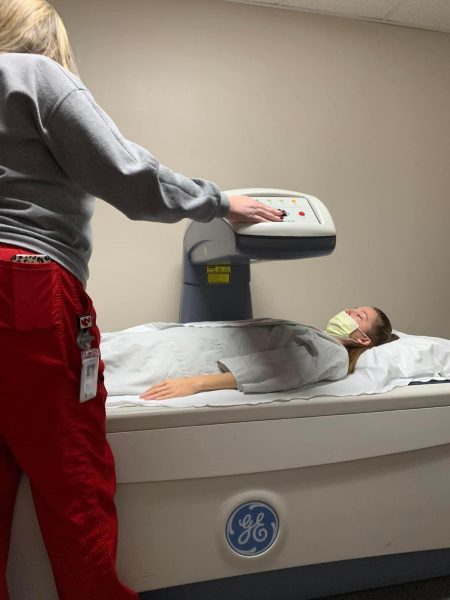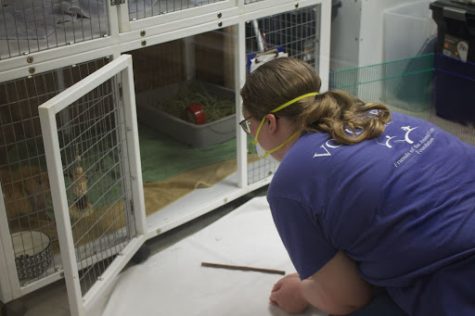They Have Feelings Too!
February 6, 2023
It is a beautiful day outside and inside: it is not too hot or too cold. It is the perfect time to spend some quality time with your animal best friend, whether it is outside or inside. While you throw the ball for your dog, rub your cat’s belly, or play hide and seek with your rabbit, have you ever had the thought of signing your animal up for animal testing?
Many things go into what animal testing is, but the simplest explanation is procedures that are performed on living animals for research purposes. According to the Humane Society International, the animals that are inducted into the experiment go through a lot. Some are exposed to chemicals or drugs no matter how dangerous it is. During the actual experiments, the pets are often food and water deprived depending on what the experiment entitles. These drugs or chemicals are often used to see the effects of medicines used in procedures. Some of the medicines help the research with genetic manipulation. Genetic manipulation is where they take or add a gene to the pet.

The Humane Society of the United States included a small list of the animals that have been used in animal testing. “Mice, fish, rabbits, guinea pigs, rats, hamsters, and birds.” These are the normal animals that would be expected to be tested on, but the Humane Society also listed some that would never be thought of. “Cats, Dogs, Monkeys, chimpanzees, farm animals.” These animals are used for a wide range of reasons. The Humane Society International lists a few of the tests and purposes the animals are being used. “Exposure to drugs, chemicals or infectious disease at levels that cause illness, pain, and distress, or death.” They also tend to go through mental tests as well. “Behavioral experiments designed to cause distress, e.g., electric shock or forced swimming.” Some of the tests done have no connection to human health and no valid reasons for continuing the testing.
As the wonder goes on about whether they can afford all this testing, Peta ads in a small part about the cost of animal testing. “One of the largest sources of funding comes from publicly funded government granting agencies such as NIH. Approximately 47 percent of NIH-funded research involves experimentation on animals, and in 2020, NIH budgeted nearly $42 billion for research and development.” How do they get all of that money for animal testing? Well, Peta also talks about where they get some of the money. “In addition, many charities––including the March of Dimes, the American Cancer Society, and countless others—use donations to fund experiments on animals,” stated Peta. “One-third of the projects funded by the National Multiple Sclerosis Society involve animal experimentation.” So many people donate their money to help animals, but a chunk of their money is being spent on animal testing.
So many animals are used for testing but there is no way to tell how many animals are being used for many reasons. Humane Society International tells why so many tests are being unrecorded. “It is estimated that more than 115 million animals worldwide are used in laboratory experiments every year. But because only a small proportion of countries collect and publish data concerning animal use for testing and research, the precise number is unknown.” The article goes on and talks about how many laboratories do not report on the animals being used for breeding. Out of all the Animals being used a fraction are saved just for breeding so they can continue to test without filing any reports.
Someone needs to be held accountable but Peta talks about how it is harder to pin it on a specific laboratory for so many reasons. “State open-records laws and the U.S. Freedom of Information Act can be used to obtain documents and information from state institutions, government agencies, and other federally funded facilities, but private companies, contract labs, and animal breeders are exempt.” Animal testing is something that will continue for as long as they can publicly. There will always be people that try and test animals under the radar.

Animal testing has been happening for hundreds of years and will continue until a higher authority stops it. There are things that simple citizens can do to help lower the number of animals being tested on. Peta lists a couple of things that citizens can change in their everyday routine to help. “ Buy cruelty-free products, help to educate others on the matter, and students can speak up against animal dissection.” There are more ways to help than we think. “You can leave your body for science, Leaving your body will help scientists create new cures without having to use animals.” The site Peta has another site called Peta 2, in this article, they list a few in-home ways to help. “Buy cruelty-free cleaning products for your home, Buy only 100% cruelty-free products.” It is known that some household items are half-tested on animals. Buying something 100% free means that not one single part of your product is being used on animals.
If you are not sure what products are cruelty-free there are some links that sell pamphlets with a list of all cruelty-free products for you and your pets. The Peta site also has an app. On the app, they update you with actual stories of animals affected by testing, what condition they were in, and how they came upon saving those animals. While these may not be real big solutions it all starts with one individual person willing to stand up and share what they believe in. The debate over Animal testing is still going on strong, what are your views on the matter?









